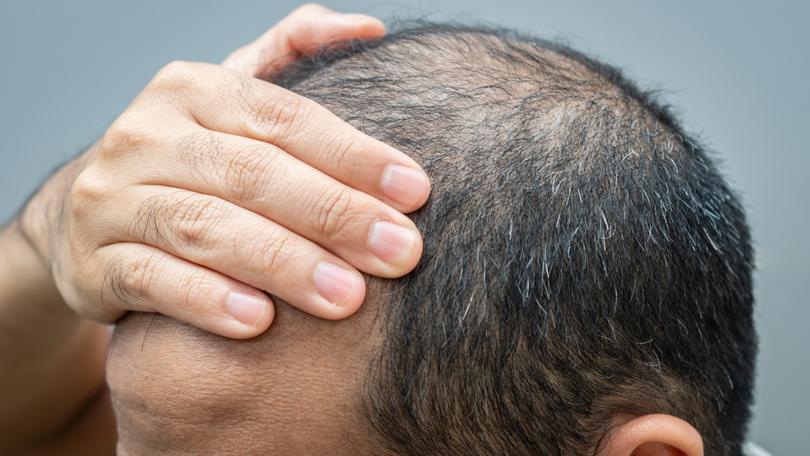How to treat and cure baldness: The exciting new methods showing real promise

Hair loss is big business — in the UK, men and women spend an estimated £150 million a year on over-the-counter remedies.
Around 80 per cent of men aged 50 have at least some hair loss, while 40 per cent of women the same age are also affected, often because of the drop in oestrogen levels during menopause (the hormone helps hairs grow).
Yet despite decades of research, science has still to come up with a cure.
Sign up to The Nightly's newsletters.
Get the first look at the digital newspaper, curated daily stories and breaking headlines delivered to your inbox.
By continuing you agree to our Terms and Privacy Policy.Existing remedies can stabilise hair loss and improve thickness slightly.
But the improvements are limited and the side-effects may be intolerable.
Around a third of people who use Regaine (a foam or lotion made with the drug minoxidil that increases blood flow to hair follicles) see little or no response.
And around one in 20 complain of side-effects including rapid heartbeat, swollen feet and stomach pains.
The evidence for caffeine shampoos, meanwhile, remains mixed, even though British consumers buy more than a million bottles a year.
Some studies suggest that applying the stimulant to the scalp can block the effects of dihydrotestosterone, or DHT — a hormone in both men and women that makes hair fall out or shrink and become brittle.
But other studies suggest little improvement.
More powerful hair loss drugs are available on private prescription (but not on the NHS), including Propecia.
Taken as a daily tablet, this contains the drug finasteride which also blocks DHT and can trigger new hair growth in up to 80 per cent of men.
But it’s been linked with erectile dysfunction in up to 3 per cent of those who use it.
In the absence of an easy fix, it’s hardly surprising that thousands of British men every year jet off to countries such as Turkey for hair transplants at a fraction of the cost in the UK.
But are there better and potentially safer treatments coming down the line?
Here we look at some of the promising new baldness cures being developed.
SUGAR GEL MAKES HAIR GROW BACK
The cure for hair loss could be a lot closer to home than anyone realised, according to recent research by scientists at Sheffield University.
They found that a type of sugar that occurs naturally in the body — 2-deoxy-D-ribose — can trigger hair growth when used in a gel for the scalp.
The sugar stimulates the growth of new blood vessels to carry oxygen-rich blood to organs and tissues.
The researchers were actually looking into whether it could help heal wounds by boosting blood supply to the area.
But in tests on mice they noticed it also prompted new hair growth, reported the journal Frontiers in Pharmacology.
It’s thought the gel penetrates the skin, triggering the formation of tiny blood vessels that feed into hair follicles.
And it’s now believed to hold promise as a treatment for androgenetic alopecia (or male pattern baldness), the leading cause of hair loss in men, usually due to genes inherited from both parents.
(Women also suffer genetic hair loss but it tends to result in thinning from the top, rather than all-over hair loss.)
LOTION WITH FEWER SIDE-EFFECTS
One problem with drugs such as finasteride is that they’re usually taken as a tablet, so have to pass through the stomach, then into the bloodstream and circulate around the body, increasing the chances of side effects.
A rival drug currently in trials in the US works in a similar way but comes as a rub-on lotion applied once or twice daily, with fewer adverse effects.
Called Breezula, the lotion contains clascoterone, a drug already used in acne cream in the US — it stops DHT stimulating the release of inflammatory chemicals and fats that trigger spots.
In a trial involving 18 men with male pattern baldness, reported in the Journal of the American Academy of Dermatology in 2019, researchers found the lotion increased the diameter of hair shafts — suggesting it leads to thicker hair — and also increased the number of hair follicles.
The results of bigger trials in the US, Germany and Poland — involving up to 1500 men — are due early next year.
“This could potentially be a very useful treatment,” says Dr Christos Tziotzios, a consultant dermatologist at St John’s Institute of Dermatology at Guy’s and St Thomas’ NHS Foundation Trust in London.
“Clascoterone seems to be able to block the effects of DHT. Bigger trials [will] confirm [if] it is effective and safe.”
COULD HAY FEVER PILL BANISH BALDNESS?
Millions of us take them during the pollen season but now research suggests certain hay fever drugs could also hold the secret to combating hair loss.
Cetirizine in particular is attracting widespread interest.
It’s an antihistamine, which means it blocks the release of histamine, a chemical pumped out by the body in large quantities when it detects the presence of something harmful, such as an allergen.
Several studies have found that a solution with 1 per cent cetirizine can also tackle genetic hair loss in men and women.
In a study with 33 men, published in the Journal of Cosmetic Dermatology last September, researchers in Iran showed that rubbing the lotion into the scalp twice a day was as effective as Regaine but with fewer side effects.
It’s thought the drug blocks the production of a type of prostaglandin, a compound released by the body to boost healing, ease pain and keep blood vessels healthy.
A specific form, prostaglandin D2 (PGD2), is found in excess levels in the scalps of bald men and is known to stunt hair growth.
Studies have shown cetirizine can reduce PGD2 production.
Dr Tziotzios said: “There is anecdotal evidence that some antihistamines can help with certain forms of hair loss.
“But we need more research — I would urge patients not to take hay fever drugs in the hope that it might help their hair.”
The pills can cause side effects such as fatigue, headaches, dry mouth, nausea and dizziness — and are unlikely to reach the scalp in sufficient concentration to have an effect.
CREAM MADE FROM ‘SUNSHINE VITAMIN’
A lack of vitamin D (produced by the body with exposure to the sun’s UV rays) is known to increase the risk of thinning hair — it disrupts the growth cycle and weakens the dermis, the layer of skin that holds hair in place.
But could a cream made with vitamin D reverse the loss in women — even if they’re not necessarily vitamin D deficient?
That’s what a clinical trial at Sohag University in Egypt is exploring — 45 women with genetic hair loss are using the cream twice daily for three months; the results will be compared against women using Regaine (minoxidil).
A new study in the Journal of Nutrition Biochemistry found that bald mice sprouted new hairs when given vitamin D.
It’s thought the vitamin counters the harmful effects of DHT on delicate hair follicles, but it’s unlikely a vitamin D cream will make a significant difference in patients who are not deficient in it, warns Dr David Fenton, a consultant dermatologist and hair loss specialist at the OneWelbeck clinic in London.
“You’d also need to be sure that the hair loss was not caused by a deficiency in some other vitamin — such as B12 [important for the formation of red blood cells],” he says.
DRUG THAT’S USED FOR ARTHRITIC JOINTS
Another common cause of hair loss is alopecia areata, affecting an estimated 400,000 UK men and women, causing the sudden appearance of bald patches.
The hair usually grows back, although it can fall out again in future.
Earlier this year, the National Institute for Health and Care Excellence approved the use of a new medicine, ritlecitinib, for alopecia areata.
The tablet was originally developed for patients with rheumatoid arthritis, where the immune system mistakenly attacks the joints.
A similar thing happens in alopecia areata – the immune system mistakenly attacks the hair follicles.
During trials on arthritis patients, doctors noticed new scalp hair also started to sprout in those with bald patches.
It’s thought the drug, from a class called Janus Kinase (JAK) inhibitors, blocks enzymes that prevent hair from regrowing in alopecia areata.
“These are good drugs but they’re not a magic cure and they can have unpleasant side effects,” says Dr Fenton.
These include skin infections, chest infections and potentially life-threatening blood clots.
INJECTION OF JELLY COULD HELP REGROWTH
Stem cells harvested from a jelly found in umbilical cords could be a new treatment for some types of hair loss.
Called Wharton’s jelly, it’s found in abundance in the umbilical cord, insulating and protecting it.
Scientists have found it’s also a rich source of stem cells — master cells that can grow into any type of organ or tissue.
Now researchers at a private New York clinic are exploring whether stem cells harvested from the jelly and injected into thousands of hair follicles in the scalp can treat genetic hair loss.
The 12-month study, due to finish next July, will compare the results with a placebo treatment.
